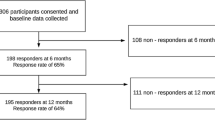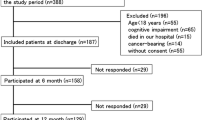Abstract
Introduction
Most studies of polytrauma examined highly mixed patient groups. The objective of the present study was to report the development of patient-reported quality of life (QOL), in a patient group with musculoskeletal polytrauma, excluding patients with major thoracic, abdominal, and brain injuries.
Materials and methods
The study design was a 1-year cohort follow-up study. Recordings of injury severity were measured with the ISS and NISS. Patient-reported QOL was measured with the questionnaires Eq5d-5L and SF-36 and compared to age-matched reference populations. Moreover, patients return to work status was measured. Data were collected prospectively at discharge, 3, 6, and 12 months.
Results
53 patients were included. The mean age was 42.3 years, ranging from 17 to 78 years. Twelve months after trauma admission, the mean Eq5d-5L index was 0.601 (95 % CI 0.546–0.657). A progressive increasing Eq5d-5L index and SF-36 PCS was observed between the discharge and the 12-month follow-up (p < 0.001). The development in QOL from 6 to 12 months almost shows identically scores. Throughout the study period, patients reported significant worse QOL compared with the established reference population. 32 % of patients have resumed earlier employment status at 1-year follow-up.
Conclusions
Throughout the 12-month observational period, patients reported worse QOL compared to the age-matched reference population. The development of QOL from 6- to 12-month time points almost showed identically scores with only little improvement. At the end of 1-year follow-up, 32 % of patients had resumed prior employment status.




Similar content being viewed by others
References
Bouillon B, Neugebauer E (1998) Outcome after polytrauma. Langenbecks Arch Surg 383:228–234
von Ruden C, Woltmann A, Rose M, Wurm S, Ruger M, Hierholzer C, Buhren V (2013) Outcome after severe multiple trauma: a retrospective analysis. J Trauma Manag Outcomes 7:4-2897-7-4
Fern KT, Smith JT, Zee B, Lee A, Borschneck D, Pichora DR (1998) Trauma patients with multiple extremity injuries: resource utilization and long-term outcome in relation to injury severity scores. J Trauma 45:489–494
Zelle BA, Brown SR, Panzica M, Lohse R, Sittaro NA, Krettek C, Pape HC (2005) The impact of injuries below the knee joint on the long-term functional outcome following polytrauma. Injury 36:169–177
Holtslag HR, van Beeck EF, Lindeman E, Leenen LP (2007) Determinants of long-term functional consequences after major trauma. J Trauma 62:919–927
Regel G, Lobenhoffer P, Grotz M, Pape HC, Lehmann U, Tscherne H (1995) Treatment results of patients with multiple trauma: an analysis of 3406 cases treated between 1972 and 1991 at a german level I trauma center. J Trauma 38:70–78
Anke AG, Stanghelle JK, Finset A, Roaldsen KS, Pillgram-Larsen J, Fugl-Meyer AR (1997) Long-term prevalence of impairments and disabilities after multiple trauma. J Trauma 42:54–61
Butcher JL, MacKenzie EJ, Cushing B, Jurkovich G, Morris J, Burgess A, McAndrew M, Swiontkowski M (1996) Long-term outcomes after lower extremity trauma. J Trauma 41:4–9
Meerding WJ, Looman CW, Essink-Bot ML, Toet H, Mulder S, van Beeck EF (2004) Distribution and determinants of health and work status in a comprehensive population of injury patients. J Trauma 56:150–161
MacKenzie EJ, Morris JA Jr, Jurkovich GJ, Yasui Y, Cushing BM, Burgess AR, DeLateur BJ, McAndrew MP, Swiontkowski MF (1998) Return to work following injury: the role of economic, social, and job-related factors. Am J Public Health 88:1630–1637
de Moraes VY, Godin K, Tamaoki MJ, Faloppa F, Bhandari M, Belloti JC (2012) Workers’ compensation status: does it affect orthopaedic surgery outcomes? A meta-analysis. PLoS One 7:e50251
Zelle BA, Brown SR, Panzica M, Lohse R, Sittaro NA, Krettek C, Pape HC (2005) The impact of injuries below the knee joint on the long-term functional outcome following polytrauma. Injury 36:169–177
von Elm E, Altman DG, Egger M, Pocock SJ, Gotzsche PC, Vandenbroucke JP, Initiative STROBE (2008) The strengthening the reporting of observational studies in epidemiology (STROBE) statement: guidelines for reporting observational studies. J Clin Epidemiol 61:344–349
Eq-5d questionnary. http://www.euroqol.org/. Accessed Jan 2012
Sorensen J, Davidsen M, Gudex C, Pedersen KM, Bronnum-Hansen H (2009) Danish EQ-5D population norms. Scand J Public Health 37:467–474
Bjoerner JB, Damsgaard MT, Watt T, Bech P (2007) Danish manual to SF-36. J.H Schultz Grafisk A/S, LIF, Albertslund
The short form 36 health survey (SF-36). http://www.sf-36.org. Accessed Jan 2012
Baker SP, O’Neill B, Haddon W Jr, Long WB (1974) The injury severity score: a method for describing patients with multiple injuries and evaluating emergency care. J Trauma 14:187–196
Balogh ZJ, Varga E, Tomka J, Suveges G, Toth L, Simonka JA (2003) The new injury severity score is a better predictor of extended hospitalization and intensive care unit admission than the injury severity score in patients with multiple orthopaedic injuries. J Orthop Trauma 17:508–512
Sutherland AG, Johnston AT, Hutchison JD (2006) The new injury severity score: better prediction of functional recovery after musculoskeletal injury. Value Health 9:24–27
Gomberg BF, Gruen GS, Smith WR, Spott M (1999) Outcomes in acute orthopaedic trauma: a review of 130,506 patients by age. Injury 30:431–437
MacKenzie EJ, Burgess AR, McAndrew MP, Swiontkowski MF, Cushing BM, deLateur BJ, Jurkovich GJ, Morris JA (1993) Patient-oriented functional outcome after unilateral lower extremity fracture. J Orthop Trauma 7:393–401
Holbrook TL, Anderson JP, Sieber WJ, Browner D, Hoyt DB (1999) Outcome after major trauma: 12-month and 18-month follow-up results from the trauma recovery project. J Trauma 46:765–773
Vles WJ, Steyerberg EW, Essink-Bot ML, van Beeck EF, Meeuwis JD, Leenen LP (2005) Prevalence and determinants of disabilities and return to work after major trauma. J Trauma 58:126–135
Turchin DC, Schemitsch EH, McKee MD, Waddell JP (1999) Do foot injuries significantly affect the functional outcome of multiply injured patients? J Orthop Trauma 13:1–4
Seekamp A, Regel G, Tscherne H (1996) Rehabilitation and reintegration of multiply injured patients: an outcome study with special reference to multiple lower limb fractures. Injury 27:133–138
Michaels AJ, Michaels CE, Moon CH, Zimmerman MA, Peterson C, Rodriguez JL (1998) Psychosocial factors limit outcomes after trauma. J Trauma 44:644–648
Holbrook TL, Hoyt DB, Anderson JP (2001) The importance of gender on outcome after major trauma: functional and psychologic outcomes in women versus men. J Trauma 50:270–273
O’Toole RV, Castillo RC, Pollak AN, MacKenzie EJ, Bosse MJ, LEAP Study Group (2008) Determinants of patient satisfaction after severe lower-extremity injuries. J Bone Joint Surg Am 90:1206–1211
Author information
Authors and Affiliations
Corresponding author
Ethics declarations
Conflict of interest
The authors have no conflicts of interest to report. The authors did not receive benefits or grants in any form from a commercial party related directly or indirectly to the subject of this article.
Source of funding
None.
Rights and permissions
About this article
Cite this article
Larsen, P., Goethgen, C.B., Rasmussen, S. et al. One-year development of QOL following orthopaedic polytrauma: a prospective observational cohort study of 53 patients. Arch Orthop Trauma Surg 136, 1539–1546 (2016). https://doi.org/10.1007/s00402-016-2550-5
Received:
Published:
Issue Date:
DOI: https://doi.org/10.1007/s00402-016-2550-5




